Speeches Shim

Situated in the extreme south of Angola, Cunene is a semi-arid region and a transition zone between the fertile highlands of central Angola and the deserts of Namibia.
In 2009, about 25,000 residents lost their homes in floods, and many more were affected by the disaster. Since 2013, an annual drought has plagued the region and its 500,000 inhabitants. Crops and livestock have suffered. In a province where 80 percent of the population raises cattle, this is a serious threat to livelihoods.
The Angolan Government's Civil Protection Unit (CPU) in Cunene is responsible for disaster response and risk reduction efforts. In 2013, USAID trained CPU staff to respond to these dramatic climate change effects and to devise new strategies to respond to droughts and floods in the municipalities of Cuanhama, Ombajda, Namacunde and Cuvelai. The activity was implemented by World Learning and Development Workshop under the Eye Kutoloka Project.
Four current staff and seven new CPU staff were trained to produce vulnerability studies and maps of the affected areas, essential early warning tools for responding to possible future floods in low lying areas.
After the training, the CPU was able to provide early warning of flooding three or four days in advance of the event compared to just one day previously. This additional time is sufficient for the affected populations to leave the high-risk areas prior to floods.
The training also improved coordination and communication between officials across the borders of Angola and Namibia, widening the scope of the early warning system.
“Civil protection in Cunene now knows how to plan and respond in a proactive rather than a reactive manner to flood and drought disaster as a result of the mapping tools, gauging stations and technical skills provided by the project,” says Paulo Raimundo Calunga, deputy commander of civil protection for Cunene.
The project is also helping Angola to deal with droughts through low-cost water wells to provide homes and cattle with potable water. In addition, the project introduced drought-resistant millet seed as well as plastic tanks for seed and food storage. The tanks allow for longer storage time, as the content stays dry during the rainy season.
The Cunene CPU is now recognized throughout Angola as the national champion in reducing climate change vulnerability by equipping officials to meet the increasingly urgent challenge of climate change.
LINKS
Follow @USAIDAngola, on Facebook, on Flickr

Comment
Make a general inquiry or suggest an improvement.